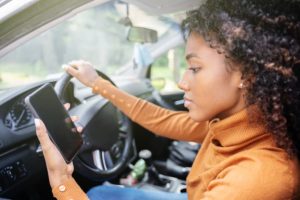Motor vehicle collisions happen every single day. What’s most frustrating is suffering through an accident caused by someone who was driving distracted. You may end up with significant injuries, mounting medical bills, and overall frustration, all because of another driver’s negligent conduct.
Motor vehicle crashes resulting from driver negligence occur for several reasons. However, distracted driving is among the top causes of car accidents. Drivers have a duty to drive in a manner that is reasonable and safe, but when they become distracted for any reason, they put themselves and others at risk of serious accidents.
Distracted driving is not a new phenomenon, as it’s been a problem for many years. Continue reading to learn more about distracted driving and how certain driving behaviors can create danger on the road. Reach out to a car accident lawyer.
Driving While Distracted is One of the Most Dangerous Driving Behaviors
Distracted driving is one of the leading causes of accidents on the road. In a recent year alone, over 3,000 individuals died, and about 42,000 suffered injuries in accidents resulting from distracted driving. States across the country have passed distracted driving laws designed to keep motorists safe.
Distractions are everywhere while driving; they are often inevitable. It is up to drivers themselves to avoid becoming overwhelmingly distracted and focus entirely on the road. When a driver becomes distracted, accidents and severe injuries are more likely.
The Three Categories of Distractions
The National Highway Traffic Safety Administration divides driving distractions into three separate categories:
- Visual distractions
- Manual distractions
- Cognitive distractions
In general, anything that takes someone’s full attention away from the road is a distraction. However, some distractions are worse than others, as they can substantially endanger the driver and others on the road.
The Most Common Kinds of Driving Distractions
Distractions while driving are plentiful, but the most common types of driving distractions are listed below.
Visual Distractions
Visual distractions take a driver’s eyes entirely off the road. These types of distractions are some of the most common.
Texting
Texting and driving is arguably the most common driver distraction in today’s world. On average, drivers look down at their phones for five seconds at a time. While this may not seem like much time, it is definitely enough time to cause an accident. If a person is driving 55 miles per hour, they can drive the length of an entire football field just within five seconds.
Texting and driving is arguably the most common driver distraction in today’s world among adult and teen drivers. On average, drivers look down at their phones for five seconds at a time. While this may not seem like much time, it is definitely enough time to cause an accident. If a person is driving 55 miles per hour, they can drive the length of an entire football field just within five seconds.
Drivers of all ages text and drive, but it occurs most frequently with teen drivers. About 42 percent of drivers of high school age admit to texting while driving.
Using GPS
While many drivers believe there is nothing wrong with using GPS while driving, it can still take their eyes off the road for an extended period. This is especially true when they have no idea where they are going. Not only is a driver looking at their navigation system trying to figure out directions, but they might also become stressed and agitated.
Drivers should always plan routes before getting on the road to avoid any issues. This minimizes frustration and allows for easy and smooth drives without the need to constantly check the GPS. Additionally, if a GPS is necessary, many GPS apps and vehicles provide voice-guided directions.
Changing the Song on the Radio or Phone
Just about everyone enjoys listening to songs, podcasts, or audiobooks while on the road, especially during road trips and long commutes. However, changing a song on the radio or choosing the next tune on the phone can take a driver’s eyes off the road for several seconds at a time—just enough time for an accident to occur.
Creating a playlist pre-drive and having pre-saved radio stations can help limit the chance a driver will need to pick up the phone or fiddle with the radio.
Looking for a Lost Item
Everyone has experienced this at least once—they are in the middle of driving when something falls between the seats or onto the floor. It might seem like an acceptable idea to some people to multitask and continue driving while looking for the item, but this can quickly result in a severe collision.
If a driver drops an item, they should let it go and avoid looking for it while the vehicle is in motion. If they need the item right away, they should pull over to the side of the road to look for the item.
Talking to Passengers in the Vehicle

Talking while driving is usually not a problem, so long as eyes and attention remain on driving. It may be tempting for a driver to look at the person while speaking, but it is important that they refrain from doing so. The other person should understand.
Further, drivers should avoid getting into heated conversations or arguments with passengers, as this can result in severe distractions and crashes.
Manual Distractions
Manual distractions are those that physically take a driver’s hands off the steering wheel.
Eating and Drinking
Eating and drinking while driving is especially common. Sometimes, drivers need to have a quick meal while behind the wheel. However, eating and drinking while operating a vehicle can easily require one or even both hands, which is extremely dangerous.
If someone needs a quick bite, they can still do so in their car, but they should pull over to the side of the road. Even the simplest actions, like dipping a fry in sauce or holding a sandwich, can result in a collision.
Grooming/Applying Makeup
Grooming and applying makeup frequently happens behind the wheel, especially when drivers are running behind schedule, leaving little time to do this at home.
Fixing their hair or putting on an extra swipe of lipstick might seem necessary, especially when they want to look your best wherever they are going. Still, drivers should wait to do these things until they’re completely parked to avoid any negative repercussions.
Dealing With Children and/or Pets
Being a parent is no easy feat, whether to children and/or pets. It’s very common for children and pets to become restless, rowdy, or need help while someone is trying to drive. This usually results in a driver taking their hands off the wheel for one reason or another.
By doing so, they not only put themselves and their children at risk but also others on the road. If absolutely necessary, drivers should pull over before considering taking their hands off the steering wheel while driving.
Holding the Phone While Talking
A large majority of drivers believe talking on the phone isn’t as dangerous as texting. In reality, it can be just as dangerous.
While there are available features that can make talking on the phone a bit safer while driving, like hands-free Bluetooth connections, many drivers still talk on the phone the old-fashioned way—holding their phone to their ear.
Talking on the phone while holding it is a form of physical distraction. Speaking on the phone is also a sort of cognitive distraction, especially depending on who the driver is speaking with and the subject matter of the conversation. Therefore, the dangers of talking on the phone while driving are two-fold.
Smoking
Smoking isn’t just keeping the cigarette in between a driver’s fingers while driving. When a driver smokes, they must also take their hands off the wheel to reach for their cigarettes, light up the cigarette, and ash it every so often.
At this point, just about everyone is aware of the dangers of smoking. On top of the health risks, smoking can also be dangerous behind the wheel, easily distracting a driver enough to cause an accident.
Cognitive Distractions
Cognitive distractions take a driver’s mind off of driving.
Daydreaming
Everyone does it—they are driving, daydreaming about something, and by the time they come to, they’ve driven a mile or two without knowing where the time went. Daydreaming or “zoning out” is a general state of inattentiveness – getting lost in thought with a wandering mind.
While everyone daydreams, it’s best for drivers not to do it behind the wheel of a car. The Insurance Institute for Highway Safety (IIHS) has daydreaming at the top of the list for distracted driving, reporting it as the number one reason for fatal crashes involving distracted drivers.
Fatigue
You’ve likely heard adults should get seven to nine hours of sleep every night, but few do. In reality, about 37 percent of working adults regularly get less than the recommended minimum of seven hours of sleep per night.
Driving while fatigued can cause the same or similar bodily effects as being under the influence of alcohol. Drivers fail to be as alert and well-functioning as they should be behind the wheel.
Driver fatigue is an especially significant problem among commercial truck drivers. This is because, often, drivers have strict schedules with hard deadlines to deliver their cargo. Therefore, many drivers fail to sleep the hours they should, if at all, to avoid missing these deadlines.
Drivers who experience substantial fatigue are at risk of nodding off while driving, making poor decisions, and reacting much more slowly.
Stress and Emotions
Stress affects people in many ways, and everyone reacts to stressful situations differently. If a driver is feeling overwhelmed or is experiencing heightened emotions, it may be best for them to stay off the road.
For example, if someone is sad or crying, they may be more prone to zoning out or taking their eyes off the road or hands off the wheel. If they’re angry or frustrated, they’re more likely to drive aggressively, which is another dangerous behavior.
If someone is feeling unwell mentally or emotionally, it’s best for them to take some time to cool off before getting on the road. Otherwise, they can cause accidents and injuries.
Driving Under the Influence
Everyone knows the dangers of driving while under the influence, but unfortunately, countless drivers still do it. Driving while impaired involves operating a vehicle while under the influence of alcohol or drugs.
Impaired driving significantly impacts a driver’s ability to drive responsibly and safely. Reaction times are slower, and focus and coordination are affected.
In the U.S., about 32 people die every single day from alcohol-related car accidents, which comes out to approximately one death every 45 minutes.
Impaired driving affects a driver cognitively, substantially increasing the chances of distractions and collisions resulting in severe injuries and even death.
Distracted Driving Causes Various Types of Car Crashes
Distracted drivers are not only at risk for hitting other drivers on the road; others sharing roadways, including bicyclists and pedestrians, are in danger.
One in five victims of fatal distracted driving accidents was not in a vehicle. Instead, they were riding bikes, walking, and otherwise outside their cars at the time of the collision.
Distracted driving puts everyone at risk. Therefore, drivers need to be mindful of others, focus on safe driving, and respect their duties as responsible drivers.
What to Do if a Distracted Driving Accident Injured You
When you’re involved in a car accident and suspect the other driver is at fault due to distracted driving, call 911 to report your accident. Speak to law enforcement and give them your account. The information you provide can help them create your police report, which is a crucial piece of evidence in an accident claim.
If you suffer injuries, be sure to seek medical attention right away. Your medical records can play a vital role in your claim.
Finally, be sure to consult with a lawyer for further assistance regarding your collision case.
Discuss Your Situation With a Qualified Car Accident Attorney

Car Accident Attorney, Phillip J. Barkett
If you or a loved one are the victims of a distracted driving accident, do not wait to discuss your case with a car accident lawyer. If you suffer injuries in your collision, you want to act as quickly as possible to help protect your rights to fair compensation.
An experienced personal injury lawyer can give you the advice and guidance you need. They can help put you in the best possible position to obtain a favorable outcome.



